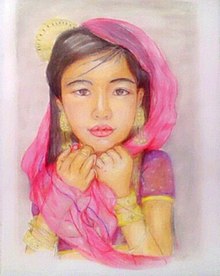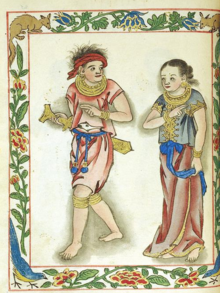| This article needs additional citations for verification. Please help improve this article by adding citations to reliable sources. Unsourced material may be challenged and removed. Find sources: "List of ancient Philippine consorts" – news · newspapers · books · scholar · JSTOR (September 2017) (Learn how and when to remove this message) |
This is a list of the queen consorts of the major kingdoms and states that existed in present-day Philippines. Only the senior queens—i.e. those with the rank of Dayang ("Lady") and Lakambini ("Queen")—are listed.
Rankings of consorts
See also: Filipino styles and honorifics



Prior to the Archaic epoch (c. 900–1565), the consorts of the Filipino monarchs were organized in three general tiers: Dayang (ᜇᜌᜅ᜔), Lakambini (ᜎᜃᜋ᜔ᜊᜒᜈᜒ), and Binibini (ᜊᜒᜈᜒ ᜊᜒᜈᜒ), or even the word Hara (ᜑᜇ) is a Malayo-Sanskrit terms in which referred to a Queen in western sense, also meant the chief queen of the states and polities which is in the influence of India or Animist states (see also Indianized kingdoms).
The title Sultana or sultanah is an Islamic title and a feminine form of the word Sultan. This term has been legally used for some Muslim women monarchs and sultan's consorts. Nevertheless, westerners have used the title to refer to Muslim women monarchs specially in the southern part of the Philippines, which is in the Islamic influence (like Sulu and Maguindanao), sultan's women relatives who don't hold this title officially.
| Rank | Title in Baybayin / Arabic-Jawi | Description |
|---|---|---|
| Hara | (Tagalog: ᜑᜇ) | Queen consort of a Raja |
| Dayang | (Tagalog: ᜇᜌᜅ᜔) | Court lady or a female Chief spouse of Datu |
| Lakambini | (Tagalog: ᜎᜃᜋ᜔ᜊᜒᜈᜒ) | Queen of the Palace or Chief Consort of Lakan |
| Binibini | (Tagalog: ᜊᜒᜈᜒᜊᜒᜈᜒ) | A Princess also a Court lady |
| Dayang-dayang | (Tagalog: ᜇᜌᜅ᜔ ᜇᜌᜅ᜔, Arabic: دايڠ دايڠ) | A Princess also a Court lady later become Queen consort of a Sultan or a Raja in Mindanao |
| Sultana | Arabic: سلطانه (sulṭānah) | An Islamic title and a feminine form of the word Sultan. This term has been legally used for some Muslim women monarchs and sultan's consorts. Nevertheless, westerners have used the title to refer to Muslim women monarchs and sultan's women relatives who don't hold this title officially. |
List of consorts
Legendary consorts
- Legendary consorts and their husbands are mentioned in the folktales and oral traditions.
| Image | Consort | Rank | Became consort | Ceased to be consort | Spouse | Notes |
|---|---|---|---|---|---|---|
 |
Maria Makiling | Dayang | legendary | legendary | Captain Lara Joselito and Juan |
Maria Makiling is the guardian spirit of the mountain, responsible for protecting its bounty and thus, is also a benefactor for the townspeople who depend on the mountain's resources. In addition to being a guardian of the Mount Makiling, some legends also identify Laguna de Bay - and the fish caught from it - as part of her domain. |
 |
Magayon | Princess | legendary | legendary | a Tagalog Prince Pagtuga (eruption) | (transl. Lady Beautiful) is the heroine that appears in the legend of Mt. Mayon in Albay. |
Historical consorts
Tondo (historical polity)
| Consort | Rank | Became consort | Spouse | Notes |
|---|---|---|---|---|
| Angkatan | Dayang | c. 900 | Namwaran | Known in LCI. |
| Buka | Dayang | c. 900 | Jayadewa | Known in LCI. She was married to Senapati Jayadewa, as a bargain to clear the debt of 1 kati and 8 suwarnas of her parents Namwaran and Dayang Angkatan. |
| Dayang Kalangitan | Gat | Unknown | Gat Lontok | The co-ruler of Pasig with Gat Lontok. |
| Panginoan | Dayang | Unknown | Gat Balagtas of Sapa and Taal, Batangas | In oral tradition recounted by Nick Joaquin and Leonardo Vivencio, "Princess Panginoan of Pasig" who was married by Balagtas, the son of Emperor Soledan of Majapahit in 1300 AD in an effort consolidate rule of Namayan. |
| Lahat | Dayang | Unknown | Gat Timog | Daughter of Kalangitan and married Gat Timog. |
Namayan
| Consort | Rank | Became consort | Spouse | Notes |
|---|---|---|---|---|
| Maylac | Dayang | Arao | Spouse of Principal Arao, mother of Gat Lontok of Pasig. | |
| Sasanban | Princess or Lady | c. 1300 (according to folk tradition cited by Joaquin and Vicencio) Batangueño folk tradition (cited by Odal-Devora, 2000) | Emperor Soledan | In folk tradition recounted by Nick Joaquin and Leonardo Vivencio, a "lady of Namayan" who went to the Madjapahit court to marry Emperor Soledan, eventually giving birth to Balagtas, who then returned to Namayan/Pasig in 1300. |
| Panginoan | Dayang | Unknown | Gat Balagtas of Sapa and Taal, Batangas | In oral tradition recounted by Nick Joaquin and Leonardo Vivencio, "Princess Panginoan of Pasig" who was married by Balagtas, the son of Emperor Soledan of Madjapahit in 1300 in an effort consolidate rule of Namayan. |
Maynila (historical polity)
| Consort | Rank | Became consort | Ceased to be consort | Spouse | Notes |
|---|---|---|---|---|---|
| Unknown | Hara | c.1400s or 1500 | 1521 | Firsthand accounts generally accepted by Philippine historiographers, although with corrections for hispanocentric bias subject to scholarly peer review. The veracity of "quasi-historical" (meaning not physically original) genealogical documents also remains subject to scholarly peer review. She served as Paramount ruler of Manila after the death of her husband. Her period of reign covered the youth of Rajah Matanda, including the time Ache spent as commander of the Bruneian navy. | |
| Leila Menchanai | Puteri | 1485 (husband's reign) |
1524 (husband's reign) |
Bolkiah | She is a princess of Sulu who is the spouse of Sultan Bolkiah who invaded and conquered Sulu and Selurong in the 15th century. |
| Unknown | Dayang or Sultana | Mid to late 16th century | 1571 | Rajah Sulayman | An unnamed spouse and cousin of Rajah Sulayman of Maynila. |
Cebu (historical polity)
| Consort | Rank | Became consort | Ceased to be consort | Spouse | Notes |
|---|---|---|---|---|---|
| Humamay or Humamai |
Hara | Before 1521 (husband's reign) |
After 1521 (husband's reign) |
Rajah Humabon | Later changed its name to Juana after she converted to Roman Catholic. |
Bo-ol
| Consort | Rank | Became consort | Ceased to be consort | Spouse | Notes |
|---|---|---|---|---|---|
| Bugbung Humasanum | Dayang (Princess) | c. 12th century | Unknown (husband's reign) |
Datu Sumanga | Datu Sumanga raids China to win the hand of Dayang-dayang Bugbung Humasanum. |
Sultanate of Maguindanao
| Consort | Rank | Became consort | Ceased to be consort | Spouse | Notes |
|---|---|---|---|---|---|
| Three (3) named consorts: Angintabo Simbaan Masawang |
Dayang-dayang | 1520 (husband's reign) |
1543 (husband's reign) |
Sharif Kabungsuwan | A daughter of Macaapun Rajah, A princess from Malabang and Angintabo's niece. |
| Unknown Princess | Dayang-dayang | ? (husband's reign) |
? | Sharif Kabungsuwan | A daughter of Macaapun Rajah. |
| Daragat | Dayang | ? | The daughter of Sharif Kabungsuwan. |
Sultanate of Sulu
Main articles: List of sultans of Sulu and Sultanate of Sulu| Consort | Rank | Became consort | Ceased to be consort | Spouse | Notes |
|---|---|---|---|---|---|
| Paramisuli | Dayang-dayang | c. 17 November 1405 | ? | Sharif ul-Hāshim of Sulu | |
| Tuambaloka | Dayang-dayang | 1649 | 1650 | Rajah Bongso | A woman from Basilan who ascended to power and become the Queen consort of Jolo known for her bravery as she and her husband held of the invaders with 4,000 warriors. |
| Piandao Kiram | Hadji Dayang-dayang | Muedzul Lail Tan Kiram | |||
| Tarhata Kiram | Hadji Dayang-dayang | ||||
| Emraida Kiram | Hadji Dayang-dayang | 1967 Miss World |
See also
- First Lady or First Gentleman of the Philippines
- Binukot - Filipino cultural practice that secludes a young person (usually a young woman)
- History of the Philippines (900–1521)
- List of sovereign state leaders in the Philippines
- List of recorded Datus in the Philippines
- Filipino styles and honorifics
- Greater India
References
- ^ Odal-Devora, Grace (2000). "The River Dwellers". In Alejandro, Reynaldo Gamboa; Yuson, Alfred A. (eds.). Pasig : The River of Life. Unilever Philippines. pp. 43–66.
- Lanuza, Michelle, The Legend of Maria Makiling, archived from the original on 2 October 2007, retrieved 30 September 2007
- "A brief introduction to Filipino folklore and mythology". kuro5hin.org. 21 June 2003. Archived from the original on 24 June 2003.
- "The Legend of Magayon". Bundok Philippines. Archived from the original on 23 January 2000.
- ^ "Laguna Copperplate Inscription". All Philippines. 7 May 2010. Retrieved 17 November 2011.
- ^ Tiongson, Jaime F (8 August 2010). "Laguna Copperplate Inscription: A New Interpretation Using Early Tagalog Dictionaries". Bayang Pinagpala. Archived from the original on 29 September 2012. Retrieved 18 November 2011.
- Kimuell-Gabriel, Nancy. "Ang Tundo Sa Inskripsyon" (PDF) (in Filipino). Archived from the original (PDF) on 22 August 2017. Retrieved 29 June 2017.
- "Timeline / Pre-Colonial". City of Pasig. Archived from the original on 7 July 2017. Retrieved 8 May 2017.
- ^ Dery, Luis Camara (2001). A History of the Inarticulate. Quezon City: New Day Publishers. ISBN 971-10-1069-0.
- ^ de Aganduru Moriz, Rodrigo (1882). Historia general de las Islas Occidentales a la Asia adyacentes, llamadas Filipinas. Colección de Documentos inéditos para la historia de España, v.78–79. Madrid: Impr. de Miguel Ginesta.
- Junker, Laura Lee (1998). "Integrating History and Archaeology in the Study of Contact Period Philippine Chiefdoms". International Journal of Historical Archaeology. 2: 291–320. doi:10.1023/A:1022611908759.
- ^ "The golden history of Islam in Brunei | the Brunei Times". Archived from the original on 3 October 2015. Retrieved 2 October 2015.
- "The Filipina as ritualist and warrior". The Manila Times. 8 March 2014.
- "Product of the Philippines : Philippine History". Archived from the original on 31 October 2007. Retrieved 28 September 2007.
- ^ "Discover Bohol".
- ^ Halili, M. (2004). Philippine History. Rex Book Store. p. 52. ISBN 9789712339349. Retrieved 23 August 2015.
- ^ "8 Filipina Queens and Princesses Too Awesome for Disney Movies". 27 February 2019.
External links
- Hector Santos' A Philippine Document from 900 A.D.
- Paul Morrow's THE LAGUNA COPPERPLATE INSCRIPTION
- RAJAH HUMABON (ca. 1521) King of Cebu
- The official website of Boholchronicle
| Pre-colonial Philippine royalty of the Postclassical Era and the early modern period | |
|---|---|
| Royalty of Luzon | |
| Lakans, Datus and Rajahs of Tondo | |
| Rajahs of Maynila | |
| Lakans of Namayan |
|
| Datus of the Madja-as |
|
| Datus and Rajahs of Cebu | |
| Rajahs of Butuan |
|
| Sultans of Maguindanao |
|
| Sultans of Sulu |
|
| Sultans of Buayan | |
| Debatable, legend-based or disputed rulers are in italics. | |

